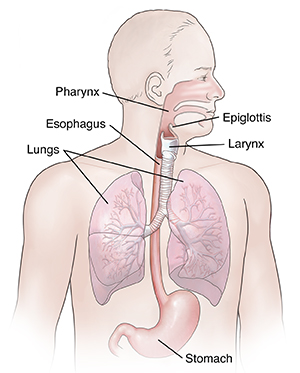Understanding Aspiration From Dysphagia
Aspiration is something entering your airway or lungs by accident. It may be food, liquid, or some other material. This can cause serious health problems, such as pneumonia. Aspiration can happen when you have trouble swallowing normally. This condition is called dysphagia.
What happens when you swallow?
When you swallow food, it passes from your mouth down into your throat (pharynx). From there, the food moves down through a long tube (esophagus) and into your stomach. This journey is made possible by a series of actions from the muscles in these areas.
The pharynx is also part of the system that brings air into your lungs. When you breathe, air enters your mouth and moves into the pharynx. The air then goes down into your main airway (trachea) and into your lungs. A flap of tissue (the epiglottis) sits over the top of the larynx (voice box). This flap blocks food and drink from going down into the trachea when you swallow.

What causes aspiration?
Aspiration from dysphagia is caused when the muscles in your throat don’t work normally. This lets food or drink enter the trachea when you swallow. This can happen as food goes down when you swallow. Or it can happen if food comes back up from your stomach.
When a person has dysphagia, aspiration is always a risk. This condition is often seen in older adults. You may be at risk for aspiration from dysphagia if you have any of these health problems:
-
Stroke
-
Brain injury
-
Spinal cord injury
-
Severe dental problems
-
Conditions that lead to less saliva, such as Sjögren syndrome
-
Mouth sores
-
Parkinson disease or other nervous system conditions
-
Muscular dystrophy
-
Blockage in the esophagus, such as a cancer growth or narrowing
-
History of radiation or surgery to treat throat cancer
Symptoms of aspiration from dysphagia
Some people who aspirate don't have any symptoms. This is called silent aspiration. Aspiration can cause symptoms such as:
-
Feeling of food sticking in your throat or coming back into your mouth.
-
Pain when swallowing.
-
Trouble starting a swallow.
-
Coughing or wheezing after eating or while eating.
-
Mild chest pain or heartburn.
-
Fever 30 minutes to an hour after eating.
-
Too much saliva.
-
Feeling congested after eating or drinking.
-
Having a wet-sounding voice during or after eating or drinking.
-
Shortness of breath or tiredness while eating.
-
Vomiting blood.
-
Pneumonia that comes back again and again.
Symptoms can happen right after eating. Or they may happen over time. You may not have all of these symptoms. They may depend on how often and how much food or drink you aspirate.
Diagnosing aspiration from dysphagia
You will need to be checked for aspiration from dysphagia if you have symptoms. You may also need to be checked if you have had a stroke or other health problem that can cause trouble swallowing. If your doctor thinks you may be aspirating, you may be told to not eat or drink until you are tested.
Your provider will ask about your health history and symptoms. This may be done by a speech-language pathologist (SLP). The SLP will try to find out if you have problems with the lower or upper part of your swallowing muscles. The SLP may ask about what foods or drinks cause problems and when your symptoms occur.
You may have a physical exam. This may include an exam of your teeth, lips, jaws, tongue, and cheeks. You may be asked to move these areas in certain ways and make certain sounds. Your SLP may also test how you swallow different types of liquids and solids.
You may also need one or more tests. These can help to find the cause of your dysphagia. Tests often help find cases of silent aspiration. Tests may include:
-
Modified barium swallow (MBS) test. This is done to show if material is going into your lungs and where the problem is along the swallowing pathway.
-
Fiber-optic endoscopic evaluation of swallowing (FEES). This test can also show if material is going into your lungs and how the structures of your throat look during and after swallowing.
-
Pharyngeal manometry. This test compares the pressure of the muscles during swallowing and finds which areas may not be working properly.